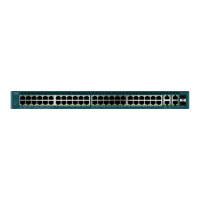IP Configuration
IPv6 Management and Interfaces
Cisco 500 Series Stackable Managed Switch Administration Guide Release 1.3 328
17
- Prefix Address—The IPv6 network. This argument must be in the form
documented in RFC 4293 where the address is specified in
hexadecimal—using 16-bit values between colons.
- Prefix-Length—The length of the IPv6 prefix. A decimal value that
indicates how many of the high-order contiguous bits of the address
comprise the prefix (the network portion of the address). A slash mark
must precede the decimal value
• Prefix Advertisement—Select to advertise this prefix.
• Valid Lifetime—Remaining length of time, in seconds, that this prefix will
continue to be valid, i.e., time until invalidation. The address generated from
an invalidated prefix should not appear as the destination or source address
of a packet.
- Infinite—Select this value to set the field to 4,294,967,295, which
represents infinity.
- User Defined—Enter a value.
• Preferred Lifetime—The remaining length of time, in seconds, that this
prefix will continue to be preferred. After this time has passed, the prefix
should no longer be used as a source address in new communications, but
packets received on such an interface are processed as expected. The
preferred-lifetime must not be larger than the valid-lifetime.
- Infinite—Select this value to set the field to 4,294,967,295, which
represents infinity.
- User Defined—Enter a value.
• Auto Configuration—Enable automatic configuration of IPv6 addresses
using stateless auto configuration on an interface and enable IPv6
processing on the interface. Addresses are configured depending on the
prefixes received in Router Advertisement messages
• Prefix Status—Select one of the following options:
- Onlink—Configures the specified prefix as on-link. Nodes sending traffic
to addresses that contain the specified prefix consider the destination to
be locally reachable on the link. An onlink prefix is inserted into the routing
table as a connected prefix (L-bit set).
- No Onlink—Configures the specified prefix as not onlink. A no onlink
prefix is inserted into the routing table as a connected prefix but
advertised with a L-bit clear.

